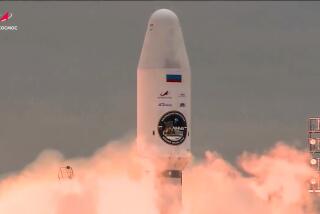Developments in Brief : Soviets Aiming to Put Craft on Mars in 1992
The Soviet Union intends to send a robot landing craft to Mars in 1992 as a second step in an ambitious plan to surpass America’s exploration of that planet, a former NASA official said last week.
Bruce Murray, now professor of planetary sciences at Caltech, said the Soviets have recently decided on such a mission as a follow-up to one set to begin in 1988 that will send a landing craft to the Martian moon Phobos.
The mission to land spacecraft on Mars itself will be accompanied by the release of camera-carrying balloons above the planet to survey broad areas of its deserts, he said.
The United States landed two Viking robots on Mars in 1976 and those missions were highly successful, sending thousands of spectacular pictures back to Earth while searching for evidence of life and monitoring Mars weather for more than two years. Murray, director of NASA’s Jet Propulsion Laboratory in Pasadena at the time the lab was controlling the Viking missions, said the Soviets plan to land spacecraft on Mars and return soil samples to Earth before the end of the century.
“So we see a very aggressive Soviet Mars program,” he said at a Washington news conference that preceded a congressional briefing.
The United States has not explored Mars since the Viking program but is now planning a modest Mars satellite mission called Mars Observer, to be launched in 1992.
Murray said that if humans ever decide to establish settlements on another planet, Mars would be the place. It is colder than Earth, has a very thin atmosphere of carbon dioxide and is very dry, but it still is the most hospitable of all the planets and is believed to have abundant water in the form of subsurface ice and polar ice caps.
More to Read
Sign up for Essential California
The most important California stories and recommendations in your inbox every morning.
You may occasionally receive promotional content from the Los Angeles Times.










